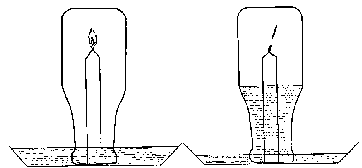

How the Great Pyramid
At Giza was built, and Why!
 "Combustion Area"
"Combustion Area" 

The workman's area above the Grand Gallery is the location of the vacuum
release valve. After the vacuum causes the water to rise in the Grand
Gallery the vacuum valve is released. This causes the water to flow
back down the Grand Gallery. The kinetic force of this movement of
water in the Grand Gallery is the motive force that makes the pump work.
Between each cycle the flame does not go out but only smolders when the
oxygen is consumed by combustion.
Below are a few excerpts from the book Pharaoh's Pump that relate to
the Combustion Area. Although they are taken out of context, they
indicate what the book talks about, and the detail of the explanation of
the Great Pyramid as a machine.
PRIME MOVER
 THE MILK BOTTLE, PIE PAN AND CANDLE
Most school kids know this trick, it moves a lot of water with
little fuel, yet it has never been used to raise water. Modern
Egypt
and other places might benefit by the crudest devise that uses
this principle!
THE MILK BOTTLE, PIE PAN AND CANDLE
Most school kids know this trick, it moves a lot of water with
little fuel, yet it has never been used to raise water. Modern
Egypt
and other places might benefit by the crudest devise that uses
this principle!
To better understand the mechanics of this great pump, and what makes it
go, we should perform a simple experiment. — Fill a pie pan full of water,
get a milk bottle, and a strap of paper. Now, light the paper, thrust
it into the bottle, turn the bottle upside down, and set it in the water.
The fire forms a vacuum in the bottle, and the water rises up in it.
Now, if air is let into the bottle, the water will drop back again into
the pan.
The fire forms the vacuum in the bottle; because it consumes
the oxygen. It goes out when the oxygen is used up. — The fire also
gives off carbon monoxide. This invisible gas, is heavier than air.
For this reason it lies like a blanket on the surface of water. Also,
carbon dioxide is soluble in water. Such a solution is slightly acid;
and makes soda water.
It will be observed, that the instant the inverted bottle touches
the water; a bubbling action occurs. This is caused by the heated
air expanding; thus forcing some of the air out. — Conversely, the cooling
of heated air in a sealed bottle will form a partial vacuum.
If the bottle remains undisturbed for a brief period, the water
will continue to rise slightly. This is due to the fact; that carbon
monoxide is being transformed to carbon dioxide; which is being dissolved
in water.
The creation of a vacuum by this means, involves three factors;
the expansion and cooling of air; the consumption of oxygen; and the conversion
of gases.
A fire burning in an airtight chamber in the pyramid, will cause this
same action, MOVEMENT. It is MOTION that makes this pump work.
Water is sucked up, and dropped. — Sucked up, and dropped. — Sucked up,
and dropped — at will.
Pure air at sea level is composed of 78.08% nitrogen, 20.9% oxygen,
and the remainder composed of rare gases. Air, at sea level has a
solubility quotient of 0.020 Fahrenheit. —Oxygen 0.034 —Nitrogen 0.017.
— Observe the solubility of the two gases. Oxygen is TWICE that of
nitrogen.
The above information is just a small portion of what Edward
Kunkel talks about in his book about this area.
 Home | FAQ
Links
Please send comments or questions regarding these web pages to
Pharaoh's Pump Foundation
Copyright © 1998 Pharaoh's Pump Foundation.
Home | FAQ
Links
Please send comments or questions regarding these web pages to
Pharaoh's Pump Foundation
Copyright © 1998 Pharaoh's Pump Foundation.



